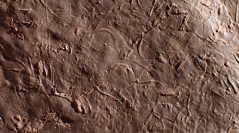

 Geodiversitas
44 (31) - Pages 975-987
Geodiversitas
44 (31) - Pages 975-987The tetrapod tracksite from Le Bousquet (Permian, Red Sandstone Group from the Rodez Basin, southern France) was discovered during the second half of the 20th century. At this time, the tracksite was only weakly prospected and underestimated. Deposits exposed near Le Bousquet were recently re-investigated. New prospections led to: 1) enlargement of the tetrapod ichnofauna (Amphisauropus latus Haubold, 1970, Batrachichnus salamandroides Geinitz, 1861, Characichnos isp., Ichniotherium isp. and Varanopus isp.); and 2) discovery of protostomian traces (Diplopodichnus biformis Brady, 1947, Scoyenia gracilis White, 1929), swimming traces of fishes (Undichna cf. britannica Higgs, 1988), rare freshwater jellyfishes (Medusina atava (Pohlig, 1892) Walcott, 1898) as well as terrestrial plant remains including leafy axes of conifers (cf. Walchia). Such a palaeontological assemblage is for the first time reported from the Permian deposits of the Rodez Basin. The depositional environment is interpreted as a fluvial zone periodically flooded and emergent, corresponding to a lake/playa system bordered by conifer-dominated forests. Ichnofossils suggest that the tetrapod fauna from Le Bousquet was mainly composed of anamniotes (diadectomorphs, seymouriamorphs, temnospondyls) whereas amniotes (captorhinid reptiles) were less common.
Rodez Basin, Permian, Tetrapod tracks, invertebrate traces, Cisuralian, photogrammetry